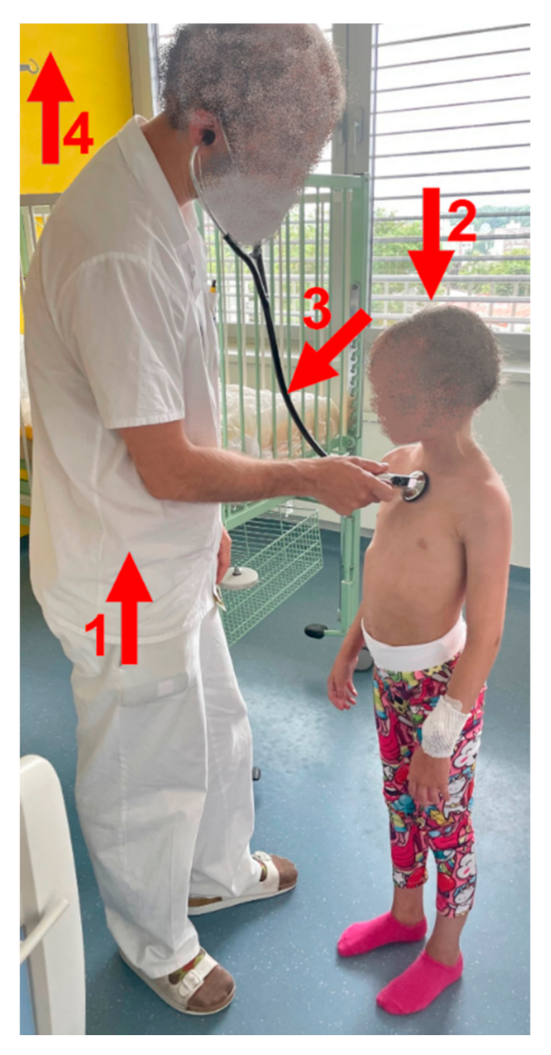Detection of Respiratory Phases in a Breath Sound and Their Subsequent Utilization in a Diagnosis
Abstract
:1. Introduction
2. Materials and Methods
2.1. Respiratory Sound Recording
Ambient and Patient’s Body Noise
2.2. Signal Processing
2.2.1. Basic Filtering
2.2.2. Data Processing and Detection of Respiratory Phases
3. Results
| Quality of Recording | Number of Recordings |
|---|---|
| very good/with minimal undesirable noise—~2 artefacts/sec or without artefacts | 22 |
| with significant noise—~1 artefact/3 s | 10 |
| very poor—~2 artefacts/sec constantly | 9 |
| Deviation of the detected boundary | |
|---|---|
| up to 0.2 s | 21 recordings |
| up to 0.4 s | 1 recording |
| The need of the software modifications | |
| none | 13 recordings |
| modification of | 5 recordings |
| mod. of low-pass filter value | 1 recording |
| mod. of and values of low-pass and high-pass filter | 3 recordings |
| Deviation of the detected boundary | |
|---|---|
| up to 0.2 s | 3 recordings |
| up to 0.4 s | 7 recording |
| The need of software modifications | |
| none | 4 recordings |
| modification of | 1 recording |
| mod. of low-pass filter value | 2 recordings |
| mod. of and values of low-pass and high-pass filter | 3 recordings |
4. Discussion
5. Conclusions
Author Contributions
Funding
Institutional Review Board Statement
Informed Consent Statement
Data Availability Statement
Acknowledgments
Conflicts of Interest
References
- Sovijärvi, A.; Vanderschoot, J.; Earis, J.E. Standardization of computerized respiratory sound analysis. Eur. Respir. Rev. 2000, 10, 585. [Google Scholar]
- Pasterkamp, H.; Kraman, S.S.; Wodicka, G.R. Respiratory sounds. Advances beyond the stethoscope. Am. J. Respir. Crit. Care Med. 1997, 156, 974–987. [Google Scholar] [CrossRef] [PubMed]
- Vannuccini, L.; Earis, J.E.; Helistö, P.; Cheetham, B.M.G.; Rossi, M.; Sovijärvi, A.R.A.; Vanderschoot, J. Capturing and preprocessing of respiratory sounds. Eur. Respir. Rev. 2000, 10, 616–620. [Google Scholar]
- Sovijärvi, A.R.A.; Dalmasso, F.; Vanderschoot, J.; Malmberg, L.P.; Righini, G.; Stoneman, S.A.T. Definition of Terms for Applications of Respiratory Sounds. Eur. Respir. Rev. 1999, 10, 597–610. [Google Scholar]
- Sovijärvi, A.R.A.; Malmberg, L.P.; Charbonneau, G.; Vanderschoot, J.; Dalmasso, F.; Sacco, C.; Rossi, M.; Earis, J.E. Characteristic of breath sounds and adventitious respiratory sounds. Eur. Respir. Rev. 2000, 10, 591–596. [Google Scholar]
- Huq, S.; Moussavi, Z. Automatic breath phase detection using only tracheal sounds. In Proceedings of the 2010 Annual International Conference of the IEEE Engineering in Medicine and Biology, Buenos Aires, Argentina, 30 August–4 September 2010; IEEE: Piscataway, NJ, USA, 2010; pp. 272–275. [Google Scholar] [CrossRef]
- Earis, J.E.; Cheetham, B.M.G. Current methods used for computerized respiratory sound analysis. Eur. Respir. Rev. 2000, 10, 586–590. [Google Scholar]
- Earis, J.E.; Cheetham, B.M.G. Future perspectives for respiratory sound research. Eur. Respir. Rev. 2000, 10, 641–646. [Google Scholar]
- Nam, Y.; Reyes, B.A.; Chon, K.H. Estimation of Respiratory Rates Using the Built-in Microphone of a Smartphone or Headset. IEEE J. Biomed. Health Inform. 2016, 20, 1493–1501. [Google Scholar] [CrossRef] [PubMed]
- Moussavi, Z.K.; Leopando, M.T.; Pasterkamp, H.; Rempel, G. Computerised acoustical respiratory phase detection without airflow measurement. Med Biol. Eng. Comput. 2000, 38, 198–203. [Google Scholar] [CrossRef] [PubMed]
- Abushakra, A.; Faezipour, M. Acoustic Signal Classification of Breathing Movements to Virtually Aid Breath Regulation. IEEE J. Biomed. Health Inform. 2013, 17, 493–500. [Google Scholar] [CrossRef] [PubMed]
- Penzel, T.; Sabil, A. The use of tracheal sounds for the diagnosis of sleep apnoea. Breathe 2017, 13, e37–e45. [Google Scholar] [CrossRef] [PubMed]
- Charbonneau, G.; Ademovic, E.; Cheetham, B.M.G.; Malmberg, L.P.; Vanderschoot, J.; Sovijärvi, A.R.A. Basic techniques for respiratory sound analysis. Eur. Respir. Rev. 2000, 10, 625–635. [Google Scholar]
- MathWorks, Envelope Detection. Available online: https://www.mathworks.com/help/dsp/ug/envelope-detection.html (accessed on 8 November 2020).
- Nguyen, T.T.; Hoo, A.F.; Lum, S.; Wade, A.; Thia, L.P.; Stocks, J. New reference equations to improve interpretation of infant lung function. Pediatr Pulmonol. 2013, 48, 370–380. [Google Scholar] [CrossRef] [PubMed]
- Horacek, J.; Koucký, V.; Hladik, M. Novel approach to computerized breath detection in lung function diagnostics. Comput. Biol. Med. 2018, 101. [Google Scholar] [CrossRef] [PubMed]










Publisher’s Note: MDPI stays neutral with regard to jurisdictional claims in published maps and institutional affiliations. |
© 2021 by the authors. Licensee MDPI, Basel, Switzerland. This article is an open access article distributed under the terms and conditions of the Creative Commons Attribution (CC BY) license (https://creativecommons.org/licenses/by/4.0/).
Share and Cite
Skalicky, D.; Koucky, V.; Hadraba, D.; Viteznik, M.; Dub, M.; Lopot, F. Detection of Respiratory Phases in a Breath Sound and Their Subsequent Utilization in a Diagnosis. Appl. Sci. 2021, 11, 6535. https://doi.org/10.3390/app11146535
Skalicky D, Koucky V, Hadraba D, Viteznik M, Dub M, Lopot F. Detection of Respiratory Phases in a Breath Sound and Their Subsequent Utilization in a Diagnosis. Applied Sciences. 2021; 11(14):6535. https://doi.org/10.3390/app11146535
Chicago/Turabian StyleSkalicky, David, Vaclav Koucky, Daniel Hadraba, Martin Viteznik, Martin Dub, and Frantisek Lopot. 2021. "Detection of Respiratory Phases in a Breath Sound and Their Subsequent Utilization in a Diagnosis" Applied Sciences 11, no. 14: 6535. https://doi.org/10.3390/app11146535
APA StyleSkalicky, D., Koucky, V., Hadraba, D., Viteznik, M., Dub, M., & Lopot, F. (2021). Detection of Respiratory Phases in a Breath Sound and Their Subsequent Utilization in a Diagnosis. Applied Sciences, 11(14), 6535. https://doi.org/10.3390/app11146535






